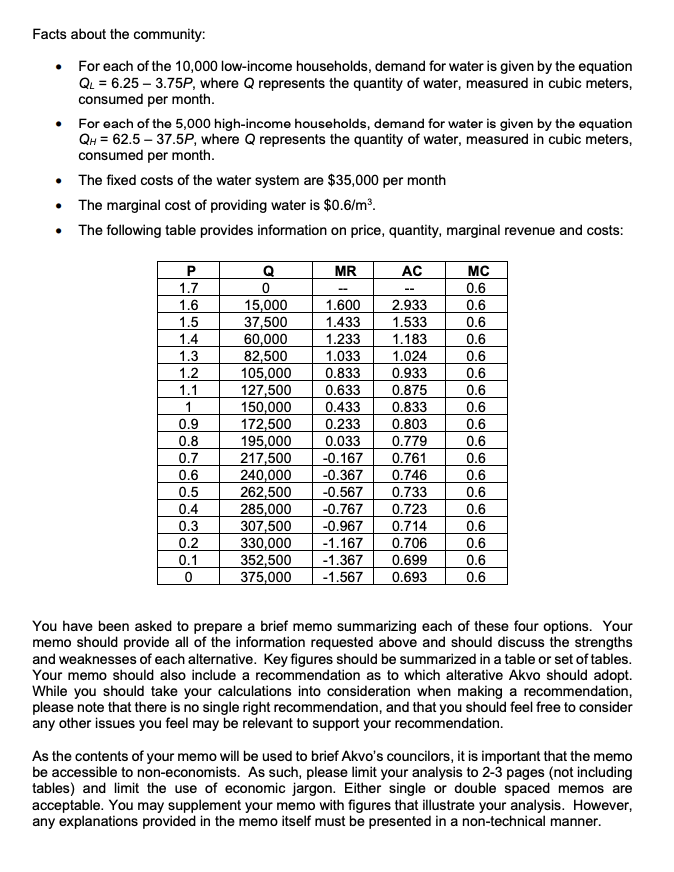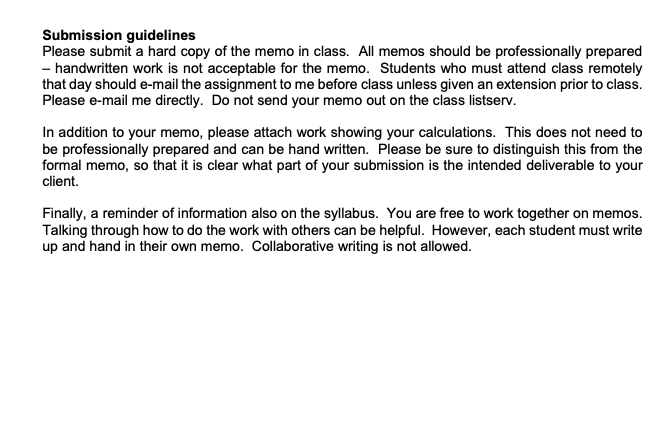Answered step by step
Verified Expert Solution
Question
1 Approved Answer
The community of Akvo is a small city in a middle-income Asian nation. The city currently provides water to its citizens through a utility



The community of Akvo is a small city in a middle-income Asian nation. The city currently provides water to its citizens through a utility run by the local community. This water system serves 15,000 households. Of these, 5,000 are considered high income households and 10,000 are low income households. In addition to these 15,000 households, an additional 2,500 poor families live in neighborhoods on the edge of town that have yet to be connected to the municipal water system, and thus do not have access to water in their homes. Currently, the price of water provided through the utility is subsidized, so that households pay just $0.3 per cubic meter (m). Because of concerns over the high cost of this subsidy, you have been asked to evaluate alternative pricing schemes for Akvo. For both the current pricing scheme of $0.3/m and each of the alternatives requested below, please provide the following information: The price (or prices) necessary to meet the goal of the alternative. How many cubic meters will the typical low-income household consume? The typical high- income household? What is the total water consumption for the community? The total cost of providing water (including fixed costs) The total revenue raised from the sale of water The profit or loss under each option. Alternative 1: Marginal Cost Pricing By raising the price to the marginal cost of providing water services, advocates of this strategy hope to reduce the burden on the municipal budget while making water as affordable as possible. Alternative 2: Privatization Advocates of this alternative call for turning management of the water system over to a private firm. The firm will be responsible for both the fixed costs and marginal costs of water provision. The firm will charge consumers a price for water that maximizes profits. Any profits made will be shared equally between the firm and the community. The community plans to use its share of profits to help families not currently connected to the municipal water system. Alternative 3: Break-even Pricing Advocates of this alternative want to remove the cost of all subsidies from the municipal budget. They call for a price that will allow the water utility to cover all of its costs, including fixed costs. Alternative 4: Minimum Allotment Advocates of this strategy note that the World Health Organization reports that households require a minimum of 4m per month for survival. They believe that any pricing strategy should guarantee at least this much consumption for each household. However, like those advocating break-even pricing, they want the utility to cover all costs, as they do not want the city to continue paying for any shortfalls. 1 Note that the table below provides information on prices in ten cent increments. Using those prices is fine. It is not necessary to extrapolate to find the effects of prices in between those in the chart. Facts about the community: For each of the 10,000 low-income households, demand for water is given by the equation QL = 6.25 -3.75P, where Q represents the quantity of water, measured in cubic meters, consumed per month. For each of the 5,000 high-income households, demand for water is given by the equation QH = 62.5 -37.5P, where Q represents the quantity of water, measured in cubic meters, consumed per month. The fixed costs of the water system are $35,000 per month The marginal cost of providing water is $0.6/m. The following table provides information on price, quantity, marginal revenue and costs: P Q MR AC MC 1.7 0 -- - 0.6 1.6 15,000 1.600 2.933 0.6 1.5 37,500 1.433 1.533 0.6 1.4 60,000 1.233 1.183 0.6 1.3 82,500 1.033 1.024 0.6 1.2 105,000 0.833 0.933 0.6 1.1 127,500 0.633 0.875 0.6 1 150,000 0.433 0.833 0.6 0.9 172,500 0.233 0.803 0.6 0.8 195,000 0.033 0.779 0.6 0.7 217,500 -0.167 0.761 0.6 0.6 240,000 -0.367 0.746 0.6 0.5 262,500 -0.567 0.733 0.6 0.4 285,000 -0.767 0.723 0.6 0.3 307,500 -0.967 0.714 0.6 0.2 330,000 -1.167 0.706 0.6 0.1 352,500 -1.367 0.699 0.6 0 375,000 -1.567 0.693 0.6 You have been asked to prepare a brief memo summarizing each of these four options. Your memo should provide all of the information requested above and should discuss the strengths and weaknesses of each alternative. Key figures should be summarized in a table or set of tables. Your memo should also include a recommendation as to which alterative Akvo should adopt. While you should take your calculations into consideration when making a recommendation, please note that there is no single right recommendation, and that you should feel free to consider any other issues you feel may be relevant to support your recommendation. As the contents of your memo will be used to brief Akvo's councilors, it is important that the memo be accessible to non-economists. As such, please limit your analysis to 2-3 pages (not including tables) and limit the use of economic jargon. Either single or double spaced memos are acceptable. You may supplement your memo with figures that illustrate your analysis. However, any explanations provided in the memo itself must be presented in a non-technical manner. Submission guidelines Please submit a hard copy of the memo in class. All memos should be professionally prepared - handwritten work is not acceptable for the memo. Students who must attend class remotely that day should e-mail the assignment to me before class unless given an extension prior to class. Please e-mail me directly. Do not send your memo out on the class listserv. In addition to your memo, please attach work showing your calculations. This does not need to be professionally prepared and can be hand written. Please be sure to distinguish this from the formal memo, so that it is clear what part of your submission is the intended deliverable to your client. Finally, a reminder of information also on the syllabus. You are free to work together on memos. Talking through how to do the work with others can be helpful. However, each student must write up and hand in their own memo. Collaborative writing is not allowed.
Step by Step Solution
There are 3 Steps involved in it
Step: 1

Get Instant Access to Expert-Tailored Solutions
See step-by-step solutions with expert insights and AI powered tools for academic success
Step: 2

Step: 3

Ace Your Homework with AI
Get the answers you need in no time with our AI-driven, step-by-step assistance
Get Started


